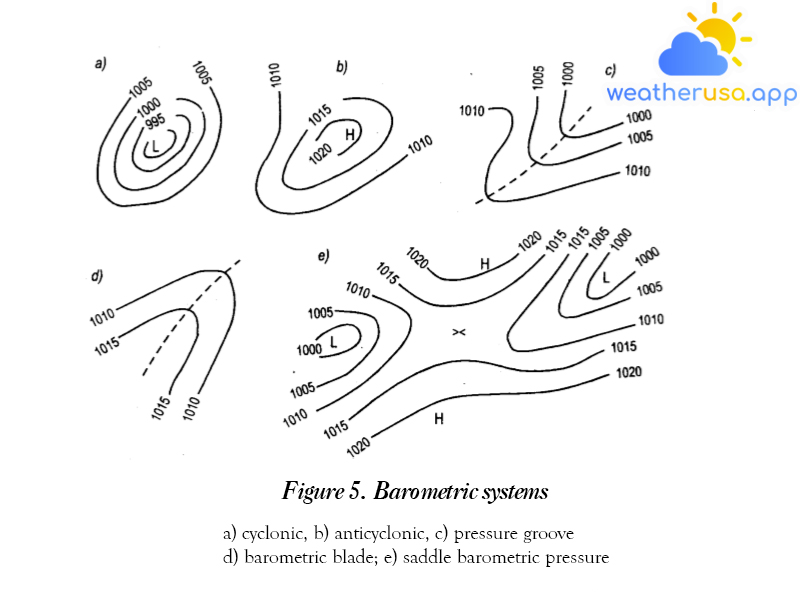
Air pressure
Air pressure
Air density and pressure
- The higher the air temperature, the higher the temperature and its density are because as the temperature of the air increases, all matter expands, and the mass per unit volume decreases.
- The higher the humidity of the air, the lower its density because the molecular weight of water vapor is only 0.622 of the molecular weight of air.
- The greater the pressure, the greater the density because in the same volume of gas, all gases are compressed more at increased anxiety, and at a decrease in anxiety, they expand rapidly. The density of dry air, denoted under normal conditions ρ, is related to barometric Po, and temperature T is as follows:
Because as we know, the mass of a column of gas depends on its density depends on latitude.
The higher the altitude, the lower the air density drops, which drops very quickly compared to temperature and humidity. So, pressure decreases with height.
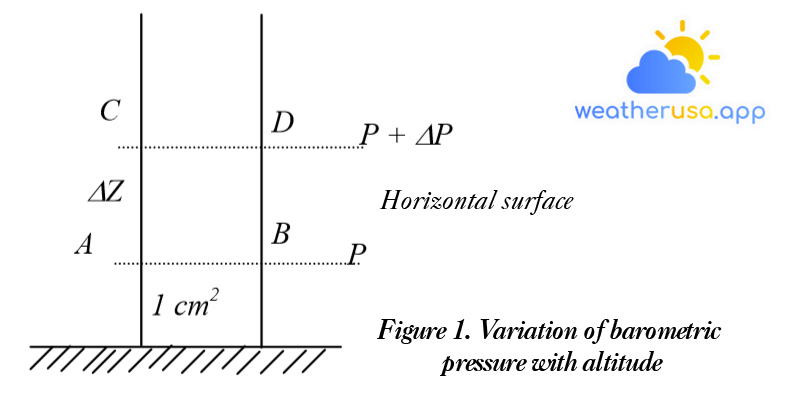
Figure 1 is derived from the basic static formula, and if the pressure P is measured on the surface AB, then at the surface CD, it is 1 cm higher than AB, an amount, ∆P reduces the pressure; dimensional level ∆P =g/cm³ x cm/s²x cm³ = g x cm/s² = 1 din.
In the international measurement system, the barometric unit is called Paskan – gas pressure 1N evenly distributed in the horizontal team of 1m² (N/m²).
In practical meteorology, the millimeter-bar and millimeters of mercury are used as the unit of measurement of air pressure.
(because 1 N = 10⁵ din )
∆P – Correction of barometric pressure according to altitude.
Methods and instruments for measuring barometric pressure
The sensitive part of this device is a thin metal canister from which air has been released.The compression and expansion of the box are transmitted using a lever system to the index hands.
The scale of the box manometer is divided into millimeters of mercury. In a box fitted with an arc mercury thermometer, the manometer is placed in a protective wooden crate so that it is always in a horizontal position.
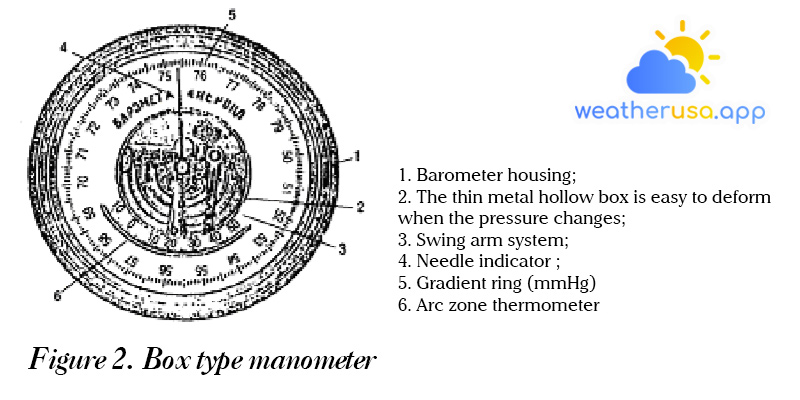
Although the reliability is lower than that of the mercury manometer, the box barometer has the advantages of robustness and portability, which is particularly advantageous for marine use and survey work.
The disadvantage is that the faulty part of the device is unstable, so it must be checked regularly.
Normally, barometric pressure is used to determine the pressure at a place, such as on a ship, on a low island, or at a height where the approximate mean sea level can be seen from a box barometer, like sea level pressure and is not corrected for temperature or gravity.
The structure of the pressure tag consists of two main parts: the sensing part and the recording part. The first is a stack of thin metal hollow boxes joined together in the shape of a spring. Compression and expansion of the pile of boxes by the action of variable barometric pressure through a system of connecting rods to the pen pole.
The nib is filled with a special ink applied to a tape wrapped around a cylindrical drum with mechanical action. Compression and expansion of the stack of boxes by variable barometric pressure through a system of connecting rods to the pen pole. The nib is filled with a special ink applied to a tape wrapped around a cylindrical drum with mechanical action.
According to the curve on the paper, we can see how the barometric pressure changed in 3 hours and the characteristics of these changes.
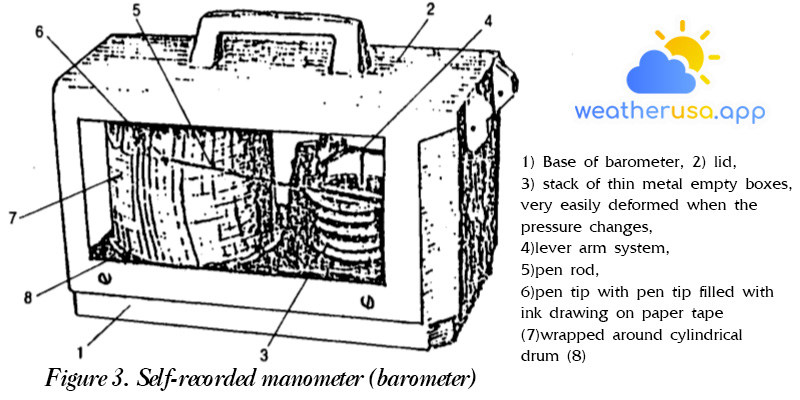
Daily and annual change in barometric pressure
Daily change in barometric pressure. These are fluctuations in barometric pressure with a day-night cycle, and they keep repeating for long periods.
According to statistics, there are always two maxima and two minima of local time in the daily barometric variations in the middle latitudes and the tropics.
The amplitude of the daily variation is more noticeable; see Figure 4.
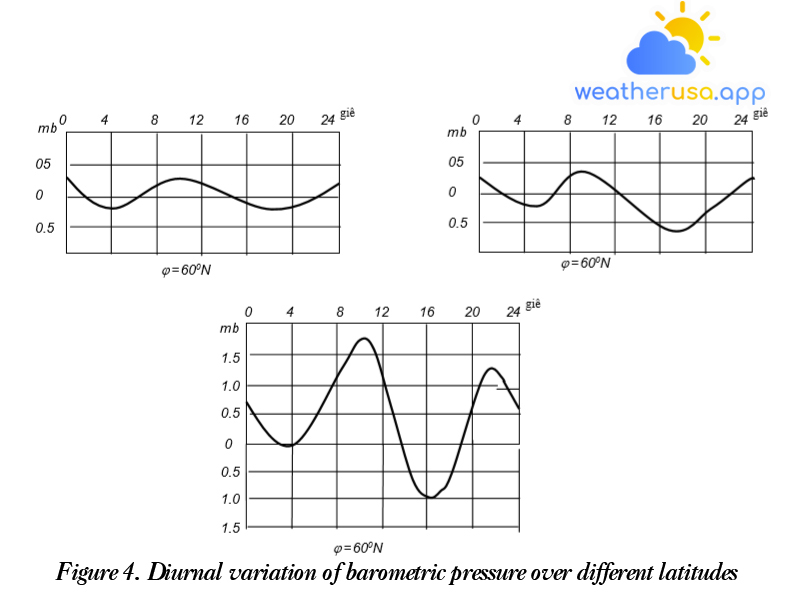
Depending on how active the eddies are in one area or the other, daily barometric pressure changes average between 3-10mb.
On the mainland, it warms but cools quickly, and on the ocean, it warms slowly and cools slowly. The phenomenon is most noticeable in middle latitudes, where the intensity of the arrival of solar heat between summer and winter is different, so on the continents, the land and the air above it often heat up sharply in the summer, observing the slightest pressure, and in the winter, when the cold air decreases sharply in density reached a maximum, barometric pressure – max.
The annual variation of barometric pressure over the continent is substantial because in Siberia, the average amount exceeds 3mb, and in other areas, about 10-15mb.
Over the oceans, the lowest pressure occurs in December and January and the highest in July–August, but the annual barometric fluctuations are more down than over land. The average yearly amplitudes in moderate latitudes are 5-6mb, and in the tropics, no more than 2-3mb.
Barometric field at the surface of the ocean
The field needs to be analyzed barometric to elucidate the characteristics of the barometric distribution at a certain point in time or over some time. Isometric lines are drawn on maps where observation data are recorded – a curve connecting similar barometric values. Isobars are marked with a spacing of 5 or 4mb or 1008, 1004, 1000, 996.
According to isobars, barometric fields are discovered. Its shape is named for barometric systems.
A barometric system is a sizeable proportional area in a barometric field with a typical barometric distribution. Pressure systems are divided into high-pressure areas and low-pressure zones with closed or non-closed pressure pipes.
A Barometric system with closed isobars – is cyclonic or anticyclonic.
Vortex – is an area of low-pressure atmospheric disturbance, represented by a system of concentric closed isobaric lines, with the value of each isopressure gradually decreasing outwards toward the center with winds swirling around the center, counterclockwise in the Northern Hemisphere and clockwise in the Southern Hemisphere.
In the center, the pressure is lowest, and the width of the cyclone in the middle latitudes is usually from 1000 km in the early stage to several thousand km at the time of maximum development. In the cyclone’s center, the letter L English typically means low.
An anticyclone is an area of high-pressure atmospheric disturbance represented by a closed system of isobaric lines whose values increase from the outside to the center where the barometric pressure is maximum, with air swirling around the center clockwise in the Northern Hemisphere and counterclockwise in the Southern Hemisphere.
The width of the pressure high can reach several thousand kilometers in the center of the pressure height. Fill in the letter H, which is the first letter high.
Barometric systems with open isobaric lines – barometric grooves, barometric vanes, barometric pressures horse saddle.
Barometric trench – is an extension of isobaric lines from the cyclonic region. Sometimes a tiny low-pressure center with two or three closed isobars appears in the barometric trough. This center is called the local vortex.

Distribution of atmospheric pressure on the earth’s surface. To clarify the characteristics of the distribution of barometric pressure over land and the ocean in different latitude zones in individual seasons, the average month of the year is mapped atmospheric pressure at sea.
The essential data used to create these maps are average barometric pressure values calculated over a long series of years at many global observation points.
But in the winter, on the same sites, anti-cyclone Xi Bia flooded. In the Southern Hemisphere, the subtropical high-pressure belt is branched into three independent anticyclones, the South Atlantic, the Southern Indian Ocean, and the South Pacific.
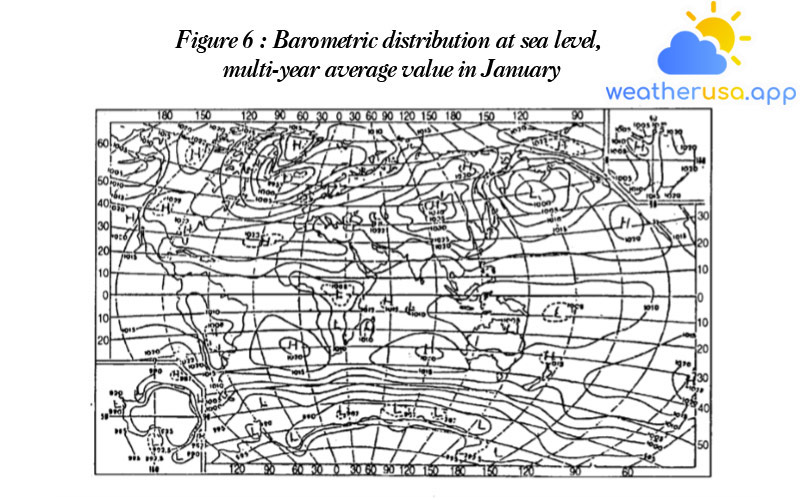
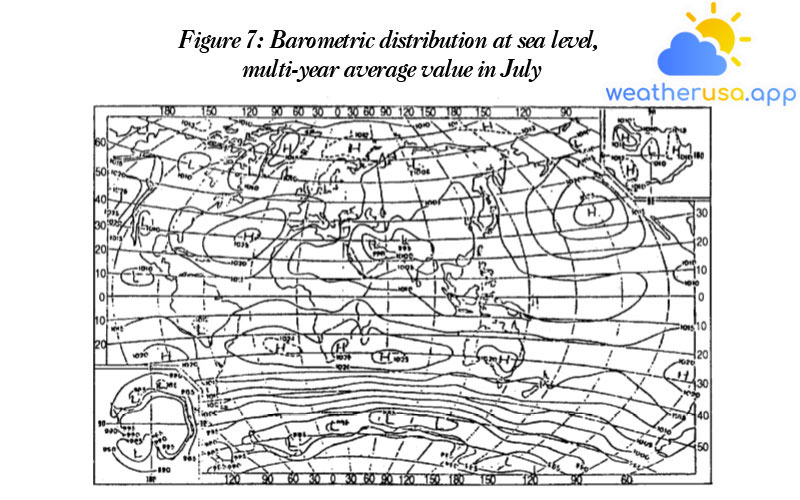
At mid-latitudes and near the poles, the pressure drops again, averaging around latitudes: in the northern hemisphere – to 1012, 1013 mb, in the southern hemisphere, at margins 60°- 70° south – 980 -985 mb.
In addition, at these latitudes the pressure distribution is relatively uniform. In the Northern Hemisphere, the average pressure along latitudes 1010-1012 mb, due to the uneven distribution of land and sea, forms many high and low-pressure areas, especially in winter.
Hurricane Aleut moves to northern Canada. Over the oceans, the Adop and Hawaiian cyclones extend northward, over the Barenxo Sea and north of the Bering Gulf appear in areas of higher pressure. In the polar regions, there are high-pressure centers that exist all year round, especially in the Antarctic high-pressure area.
Weather 01852 - Lowell MA

58°
clear sky
Feels like 57°05:36/19:47
62°F
/52°F
65%
1021 hPa
7 mi
6.91 mph



